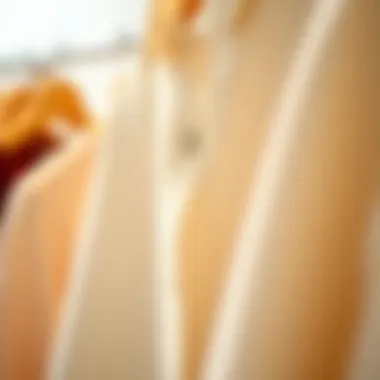Understanding Closet Moisture: Causes and Solutions


Intro
Moisture in closets can be a real thorn in the side for anyone keen on maintaining their wardrobe. It’s often an overlooked issue, and understanding the causes and effects can be a game changer. Think about it: clothes are an investment, both financially and personally. When those beloved garments become victims of damp conditions, it can lead to a cascade of problems like mildew, unpleasant odors, and even irreversible damage.
In this piece, we will unravel the factors that lead to moisture in closets. The aim? To equip you with practical insights and effective solutions ensuring your clothing stays in top-notch condition.
Possible Causes of Closet Moisture
Getting to grips with what leads to moisture build-up is crucial. Here’s a rundown of the common culprits:
- Humidity Levels: High humidity can lead to excessive moisture accumulation. The air holds more water vapor during warmer months, causing closet walls and the interior environment to become damp.
- Poor Ventilation: A closet that’s tightly closed without airflow tends to trap moist air. When air circulation is limited, it creates a perfect storm for moisture build-up.
- Substandard Building Materials: Easily forgotten, but the materials used in home construction—especially in walls and flooring—can absorb moisture. If there are defects, that humidity can seep in.
- Clothing Storage Practices: Putting damp clothes away without proper drying can contribute to increasing humidity inside your closet.
"It is the small things in life that often cause the biggest disruptions, like moisture creeping into your wardrobe."
Effects of Moisture on Clothing
So, what’s the harm in a little moisture? Well, the implications can be significant:
- Mildew and Mold Growth: One of the biggest threats posed by moisture is mildew growth. This is not just an aesthetic issue; it can ruin fabrics.
- Unpleasant Odors: Dampness can lead to musty smells that cling to your clothes, making them unpleasant to wear.
- Fabric Damage: Natural fibers like cotton or wool are particularly susceptible to damage when exposed to moisture over time. Weakening of fibers can lead to ripping or tearing.
- Appearance Issues: Stains from mildew can be tough to remove. This can ruin the appearance of your garments, making them unwearable.
In the next sections, we will dive deeper into effective solutions and how to maintain a fresh, dry closet environment. Understanding this can mean the difference between a well-kept wardrobe and one that’s in constant disarray.
Preamble to Closet Moisture
Moisture accumulation in closets is a topic that often flies under the radar, yet it bears significant implications for the longevity of our clothing and the overall health of our living spaces. The presence of excess moisture in these enclosed spaces can lead to a slew of issues that range from the merely inconvenient to the genuinely hazardous. Therefore, understanding closet moisture is not just a casual interest but a practical necessity for anyone who values their garments and health alike.
Defining Closet Moisture
Closet moisture refers to the unwanted accumulation of water vapor and humidity within the confines of a closet space. It's essential to note that this kind of moisture can result from various factors—from high humidity levels in the air to leaks from plumbing above or outside rain seeping through cracks in the walls. In layman's terms, if you find your clothes feeling damp or if you catch a whiff of mildew when you open the door, you could be facing a moisture problem.
Importance of Addressing Moisture Issues
Ignoring moisture problems can lead to severe consequences, particularly for fashion aficionados and professionals like designers and stylists. It doesn’t only risk ruining your expensive fabrics but can also trigger an environment conducive to mold and mildew growth, posing health risks such as respiratory issues and allergies.
Addressing these issues offers several advantages:
- Preservation of Clothing: Keeping moisture at bay ensures that delicate fabrics remain intact and vibrant, avoiding the fraying and discoloration that dampness can cause.
- Healthier Environment: A dry closet leads to fewer allergens and irritants, promoting a better indoor climate.
- Enhanced Storage Solutions: Frequent checks and mitigative measures can lead to better-organized spaces.
"A stitch in time saves nine." This age-old proverb rings particularly true when it comes to dealing with closet moisture. Proactive measures will save time and money in the long run, preventing the costly process of replacing damaged items or addressing mold infestations.
So, as we venture further into this discussion of closet moisture, we'll delve into its causes, identify the signs and consequences of moisture accumulation, and explore effective strategies for mitigation. Through this comprehensive exploration, readers will be equipped with practical insights to protect their wardrobes and enhance their overall living quality.
Causes of Closet Moisture
Understanding the root causes of closet moisture is essential for anyone looking to preserve the integrity of their garments and the overall health of their wardrobe. Moisture accumulation does not develop in a vacuum; it emerges from various environmental factors and poor management practices. Identifying these causes permits individuals to take proactive measures, preventing potential damage to clothing and ensuring a healthier living space.
Humidity Levels and Climate Factors
Humidity plays a critical role in the overall moisture levels within a closet. In regions where humidity is kept high, such as coastal cities, the air may feel damp even without rain. This saturation in the air can lead to a slew of issues inside enclosed spaces. Even the slightest increase in the humidity levels can spell disaster for your clothes. Clothes made from natural fibers like cotton or wool are particularly absorbent and can trap this moisture, leading to unpleasant odors and potential fabric degradation.
Additionally, climate factors can vary from one season to another, intensifying the impact of humidity. For instance, during summer months, higher moisture levels predispose closets to dampness, while winter can present a different set of challenges, such as dry air leading to static or fabric brittleness.
"The air you breathe can either be your wardrobe's friend or its worst enemy. Knowing the humidity levels in your space is key to maintaining the quality of your clothes."


Poor Ventilation in Closets
Closets, by their very nature, are often closed off from the rest of the room and can become hotbeds for moisture issues. When there is a lack of fresh air circulation, humidity accumulates and becomes trapped, creating a perfect environment for mold and mildew to sprout. This is particularly an issue in closets that have their doors tightly shut, leaving no room for air exchange.
To mitigate this problem, consider design choices such as laminate or breathable storage options, which can assist in airflow. Even creating small gaps or using louvered doors might improve the situation, allowing moisture-heavy air to escape. Whenever possible, aim to keep your closet door slightly ajar to facilitate air circulation.
Seasonal Changes and Their Effects
Seasonal shifts undoubtedly influence moisture levels in closets. For example, during the rainy season, the increased precipitation and damp air can seep into homes and notably impact closets. In contrast, during the winter, radiators or heaters in close proximity could lead to a drop in humidity levels, which can be equally damaging by drying out fabrics.
Moreover, as clothing items transition in and out of storage throughout the year, factors like wet rainy clothes being placed directly into the closet can drastically elevate moisture levels. The cyclical nature of seasons and how one prepares for each—whether it's storing summer linens away or crafting space for heavy winter attire—should be a consideration in moisture management.
Being attuned to environmental changes is paramount. Regular check-ins on closet conditions can make a massive difference and help avert moisture issues before they develop.
Consequences of Excess Moisture
Understanding the consequences of excess moisture in closets is paramount for anyone looking to maintain their clothing in optimal condition. When moisture levels rise, it’s not simply a matter of hidden dampness; the repercussions can be vast and significantly negative. Unaddressed moisture problems can lead to tangible damage to clothing, pesky growth of mold and mildew, and even potential health risks for those who inhabit the space. As we explore these aspects, it’s essential to grasp the various implications moisture poses, not only on fabrics but also on the overall environment of your closet.
Damage to Clothing Fabrics
When moisture seeps into your closet, fabrics are often the first casualties. Over time, the dampness can weaken the fibers, leading to premature fading and loss of texture. For example, cotton and silk are particularly vulnerable; they can easily absorb moisture and may develop water stains that are both unsightly and hard to remove. Such garment deterioration affects not only the aesthetic but also the longevity and functionality of the clothing.
Furthermore, certain fabrics can develop creases that become almost permanent when subjected to moisture. It is not just a matter of inconvenience; it can mean your favorite clothes don’t look their best when you pull them out for that special occasion.
Here are some specific examples of fabric damage caused by excess moisture:
- Wool can become misshapen or even shrink.
- Leather may dry out or become stiff, leading to cracks.
- Synthetic fibers, while typically more resistant, can still harbor moisture, leading to a musty smell that’s hard to eliminate.
Development of Mold and Mildew
One of the most concerning effects of excess moisture is the potential for mold and mildew to take hold. These fungi thrive in dark, damp environments, and closets provide an ideal breeding ground. The presence of mold not only raises serious alarms for your clothing but can also create hazardous living conditions.
The spores released by mold can travel through the air and find their way into the home's other areas, affecting indoor air quality. Signs of mold growth can include a musty odor or spots on surfaces, including clothing. If you spot any signs, it’s critical to act swiftly.
Here’s what mold and mildew often target:
- Cotton or Linen Fabrics: These natural fibers are especially productive places for mold to grow.
- Cardboard Storage Boxes: If they get wet, these can become hotspots for mold proliferation.
Health Risks Associated with Moisture
Lastly, but certainly not least, is the health risk linked to excess closet moisture. The presence of mold spores can become problematic for anyone with allergies or respiratory issues. Breathing in these spores can lead to a range of health issues, from slight irritation in the throat to more severe reactions such as asthma attacks or eye irritation.
Furthermore, there’s the often overlooked psychological impact of having a neglected closet filled with damp, musty clothes; it can foster feelings of unease or uneasiness in one’s personal space. Maintaining a dry and healthy closet environment isn’t just about protecting clothing—it’s about safeguarding your well-being.
Concluding Thought: The consequences of excess moisture extend far beyond wardrobe woe. By recognizing and addressing moisture issues, you protect not just your cherished ensembles but also your health and home environment.
Detecting Moisture Issues in Closets
Understanding how to detect moisture issues in closets is crucial to preserving the integrity of your garments. Closet moisture can lead to a cascade of problems—from fabric degradation to health concerns—so recognizing its presence early on can save fashion-savvy individuals a lot of headaches down the line.
Signs of Excess Moisture
Several telltale signs can help identify excess moisture in closets. Being able to spot these indicators can make a significant difference in your wardrobe maintenance.


- Visible Dampness: Check for any wet spots or the feeling of moisture on surfaces. If the air feels muggy or clammy, that’s a red flag.
- Mold or Mildew: This can manifest as a musty scent or discolored patches on walls and garments. You might even notice those pesky black or green spots on your favorite leather jacket.
- Condensation: Look for water droplets forming on interior surfaces of the closet. This is particularly common in chilly climates or poorly insulated areas.
- Warped Materials: Wooden shelves might start to warp or swell. That's the wood crying out, saying it's not happy about the humidity!
Whether it’s bubbles on a painted surface or a sticky feel on your clothes, these signs shouldn’t be ignored. Addressing these issues can significantly prolong the life of your wardrobe.
Tools for Measuring Humidity
To truly understand the moisture levels in your closet, having the right tools is essential. Humidity measurement can provide you with a clearer picture of your closet’s environment, helping you take proactive measures.
- Hygrometers: These handy devices are a must-have. They measure the relative humidity in the air. A reading above 60% often indicates a moisture problem.
- Moisture Meters: For more targeted readings, consider investing in a moisture meter. These can be used directly on wood or drywall to measure moisture content.
- Smart Home Devices: There are innovative smart gadgets that can send alerts to your phone if humidity levels exceed your set thresholds.
- Thermometers: Knowing the temperature can also assist in understanding humidity levels, since warm air holds more moisture than cold air.
Remember that maintaining a balanced humidity level, ideally between 30%-50%, is key to preventing moisture-related damage in closets.
In summary, detecting moisture is the first step toward effective management of your closet space. Pay attention to the signs and utilize tools that can assist you in keeping your wardrobe in top shape.
Mitigation Strategies for Closet Moisture
When it comes to dealing with closet moisture, proactive steps can make a significant difference. Effective mitigation strategies not only help maintain the quality of your clothing but also contribute to a healthier closet environment. By addressing moisture issues, one can protect garments from damage, keep unwanted pests at bay, and promote overall air quality. This section will explore key methods that ensure a dryer, safer closet space.
Improving Ventilation
Improving ventilation is a cornerstone strategy for dealing with excess moisture in closets. Without proper airflow, humidity levels can soar, creating a breeding ground for mold and mildew. Here are some practical ideas to enhance ventilation:
- Leave Doors Ajar: If the design allows, keeping closet doors slightly open allows airflow, reducing humidity.
- Install Ventilation Louver: Putting in ventilation louvers can promote air circulation while still keeping your closet private.
- Use Open Shelving: Opting for open shelving instead of closed cabinets can enhance air flow, allowing moisture to escape.
Keep in mind that the goal isn't just to allow humidity to escape but also to engage it within the home's overall air circulation. Proper ventilation can relieve humidity post-shower or while washing clothes, preventing excess from creeping into your storage spaces too.
Dehumidifiers and Their Effectiveness
Dehumidifiers serve as a lifeline in the battle against closet moisture. When the air feels thick and mugginess sets in, these devices work tirelessly to pull excess humidity from the air, converting it into water, which is collected or drained away. Here’s what to consider:
- Size Matters: Select a dehumidifier that's adequately sized for your closet. A small unit may struggle, while one too big can lead to overly dry air.
- Continuous Drainage Options: Many models offer a feature where you can set up a drain system to get rid of collected water without needing to empty it repeatedly.
- Regular Maintenance: Keeping your dehumidifier clean ensures it operates efficiently. Filters should be checked and changed routinely, according to the manufacturer's guidelines.
Consider how adding a dehumidifier can shield your favorite cashmere sweater from becoming a sad, moldy memory.
Use of Moisture Absorbers
Moisture absorbers act as the unsung heroes in the quest for a dry closet. These products can absorb excess moisture, preventing stagnation and potential mold growth. Here's a look at effective options:
- Silica Gel Packs: A commonly known option, these packs can be placed around boxes or in drawers to wick away moisture.
- Activated Charcoal: Not only does it absorb moisture but also odors, making it a double threat against closet unwanteds.
- Natural Absorbers: Products like calcium chloride can be effective, though ensure they are placed securely to handle any liquid they may produce.
By rotating your moisture absorbers and assessing their effectiveness, you can pinpoint the best solution tailored for your closet's humidity challenges.
"Establishing a multi-strategy approach allows for a comprehensive handling of moisture issues, ultimately ensuring a more pleasant experience with every wear."
Regularly assessing and refreshening these strategies will put you on the right path to keeping that closet a safe haven for your treasured garments.
Proper maintenance on these fronts can ensure that you won’t just be protecting your clothing, but also maintaining the overall health of your living space. For further insights into home care, refer to reputable resources like Wikipedia, Britannica, or check community discussions on Reddit.
Selecting Moisture-Resistant Materials
Understanding the materials you choose for your closets is paramount in combating moisture-related issues. Selecting moisture-resistant materials not only enhances the lifespan of your wardrobe but also shields your beloved fabrics from the detrimental effects of humidity. It includes fabrics that deter water and other materials used in closet construction that are designed to resist moisture. Doing so can prevent mold, mildew, and other unwelcome guests, ensuring your garments maintain their quality and vitality.
Types of Fabrics That Resist Moisture


When it comes to fabrics that offer resistance to moisture, there’s a plethora of options in today’s market. Some notable choices include:
- Synthetic Fabrics: Materials like polyester and nylon are inherently more resistant to moisture compared to natural fibers. They dry quickly, making them ideal for storage in humid environments.
- Merino Wool: Not only does it regulate temperature, but its fine fibers can absorb moisture without making the fabric feel wet, which is especially beneficial for activewear.
- Microfiber: Known for its soft texture, microfiber is water-resistant and often used in jackets and outdoor gear. This makes it a savvy choice for outerwear or items frequently reaching into wetter environments.
In making your decisions, consider the end use of fabrics in your wardrobe. If you often experience high humidity levels, lean towards these fabrics that provide an additional layer of protection.
Storage Solutions for Optimal Protection
The storage solutions you employ are just as crucial as the materials themselves. Here are strategies for creating an optimal environment for your garments:
- Using Breathable Garment Bags: Instead of plastic covers that trap moisture, opt for breathable fabric garment bags that allow air circulation while offering protection.
- Wooden Hangers: Consider investing in solid wood hangers rather than their plastic or wire counterparts. Wooden hangers allow for air to flow around your garments and can prevent moisture build-up.
- High-Quality Shelving: If you’re using shelves, choose those made from treated wood or moisture-resistant materials. This helps in preventing water damage if humidity levels rise.
- Humidity Control Packs: Incorporating silica gel packs or moisture-absorbing crystals within storage spaces can also work wonders. They help to tackle excess humidity, creating a safer environment for your clothing.
"Investing in proper storage solutions is like building a fortress around your cherished garments. Without it, moisture creeps in, turning sweet dreams of fashion into nightmares of decay."
With these detailed strategies for selecting moisture-resistant materials and employing effective storage solutions, you can significantly mitigate risks associated with closet moisture. This knowledge not only extends the life of your clothing but also reflects a level of sophistication in wardrobe management that fashion designers, stylists, and influencers should note.
Regular Maintenance and Monitoring
Keeping moisture in check is a bit like watering a plant: it requires regular attention. Neglect this chore, and you’ll find your closet transforming into a breeding ground for damp problems. Regular maintenance and monitoring of closet conditions not only safeguard your clothes but also spare you from strife in your fashion endeavors. A proactive stance can be the difference between a closet full of moldy garments and one that preserves your attire in impeccable shape.
Routine Inspection of Closets
Like a diligent detective, routinely inspecting your closet helps you stay a step ahead of any lurking moisture issues. Typically, a brief monthly check-up is sufficient to ensure your garments are shielded from excess moisture. Here’s what you should focus on during these inspections:
- Visual Checks: Scan the walls and floor for any discoloration or unwanted wetness. Any brownish stains or peeling paint could signal bigger concerns.
- Tap the Shelves: Feel the shelves for any dampness. If they feel like they've just left a sauna, you've got problems.
- Check for Odors: A musty smell is a telltale sign that mold or mildew may be taking root among your clothes. Fresh air should always be the dominant scent.
Developing a keen eye during these regular inspections can help catch potential issues before they escalate. Make a checklist or a habit to jot down anything suspicious.
Seasonal Preparations for Closet Care
As the seasons shift, so too do the conditions within your closet. Preparing for seasonal changes isn’t just wise; it's essential. You wouldn’t wear short sleeves in the winter, so why allow moisture to creep in without a proper strategy?
- Spring Cleaning: As the snow melts away, check for any lingering winter moisture. Empty your closet, clean thoroughly, and allow that fresh spring air to circulate.
- Summer Airflow: With high humidity during summer, consider using moisture-absorbing products. Keeping a dehumidifier running can be a lifesaver in this swelter.
- Fall Preparations: Before the cold sets in, insulate spaces and check to ensure that your closet is sealed against chilly, damp air. A few well-placed weatherstrips or a door sweep can do wonders.
- Winter Vigilance: During winter, cold air may cause condensation, so be cautious. Regularly check for ice crystals in areas where moisture might compile.
Overall, embracing a thoughtful approach to seasonal preparations not only protects your wardrobe but helps eliminate unnecessary stress down the line. By maintaining consistent monitoring, you root out any issues before they can sprout, thus keeping your cherished garments intact.
Culmination and Recommendations
Addressing closet moisture is more than just keeping clothes dry; it’s about ensuring the longevity and quality of your wardrobe. This section emphasizes why managing moisture is essential and offers practical insights to tackle this issue effectively.
There’s a certain responsibility that comes with fashion. As someone deeply rooted in this world—be it a designer, stylist, retailer, or influencer—understanding how humidity impacts clothing can not only save your assets but foster a more sustainable approach to fashion. Failing to consider moisture can lead to irreversible damage, resulting in costly replacements. The chaos of mold and mildew could knock at your door if neglecting these moisture concerns. Thus, getting cozy with the notion of prevention becomes every fashion-savvy individual’s mission.
Summary of Key Points
In our journey through the article, several pivotal points arose:
- Causes of Moisture: Humidity levels play a vital role. From the climate outside to the ventilation inside, numerous factors can lead to moisture buildup.
- Effects of Excess Moisture: Damaged fabrics and thriving mold spores present real threats to your clothing. Not only does it affect aesthetics, but it also poses health risks.
- Mitigation Strategies: Addressing moisture through improved ventilation, the use of dehumidifiers, and selecting moisture-resistant materials can safeguard your collection.
- Regular Maintenance: Routine checks and preparations, especially before seasonal changes, keep your closet in tip-top shape.
These considerations, when implemented, create a proactive approach to moisture management, allowing you to enjoy your fashion choices without fear.
Final Thoughts on Closet Moisture Management
As we wrap this discussion up, let's remember that closet moisture management is not just a chore; it’s essential to preserving the garments we invest our time and money in. Take the reins—install proper ventilation, invest in reliable dehumidifying solutions, and select materials designed to withstand moisture. Keep your eyes peeled for signs of trouble and act promptly.
In essence, turning a blind eye to moisture isn’t an option if you hold your fashion in high regard. Practicality meets style when you harness the power of effective moisture management. A little effort goes a long way in ensuring your closet remains a haven for your cherished wardrobe, allowing it to shine without the worries of moisture-related havoc.
"An ounce of prevention is worth a pound of cure."
By staying ahead of moisture issues, you cultivate not only longevity in your garments but a healthy, vibrant closet environment. Every detail matters in the world of fashion, and moisture management is just one piece of that intricate puzzle.



